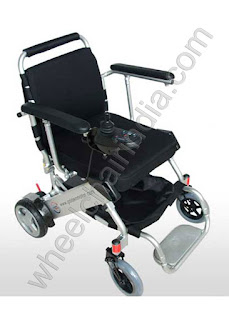Electric wheelchair or electric powered wheelchair (EPW) is a wheelchair that is propelled by means of an electric motor rather than manual power. Motorized wheelchairs are useful for those unable to propel a manual wheelchair or who may need to use a wheelchair for distances or over terrain which would be fatiguing in a manual wheelchair. They may also be used not just by people with 'traditional' mobility impairments, but also by people with cardiovascular and fatigue based conditions.
Electric wheelchair Battery:
The electric powerchairs are usually powered by 12 to 80 ampere-hour rechargeable deep-cycle batteries, the smaller batteries are used in pairs to give the chair enough power to last at least one day between charges. These are available in wet or dry options. As wet-cell batteries may not legally be carried on an aircraft without removing them from the wheelchair and securing them in a shipping container, dry-cell batteries are preferred for powerchair use. Many powerchairs carry an on-board charger which can be plugged into a standard wall outlet; older or more portable models may have a separate charger unit.
Electric wheelchair Controller:
 |
| Golden Motor Wheelchair Price Rs. 139500 |
Control of powerchairs, actually working by the detection of brainwaves or nerve signals via sensors on the scalp or elsewhere, has been demonstrated in the laboratory environment.
Electric wheelchair Seat:
 |
| Karma Kp 80 Price Rs. 308000 |
Certain high-end powerchairs feature a 'standing' capability in which either the entire seat elevates to bring the user to standing height or the seat-base, seat-back and leg rests move in conjunction to bring the user into an upright position. The powerchair may or may not be able to move while in the elevated position.
Electric wheelchair Drive System and Chassis:
Electric Wheelchair are generally four-wheeled or six-wheeled and non-folding, however some folding designs exist and other designs may have some ability to partially dismantle for transit.
4 general styles of powerchair drive systems exist:
front, centre or rear wheel drive and all-wheel drive. Powered wheels are typically somewhat larger than the trailing/castoring wheels, while castoring wheels are typically larger than the castors on a manual chair. Centre wheel drive powerchairs have castors at both front and rear for a six-wheel layout.
Powerchair chassis may also mount a kerb-climber, a powered device to lift the front wheels over a kerb of 10 cm or less.
















